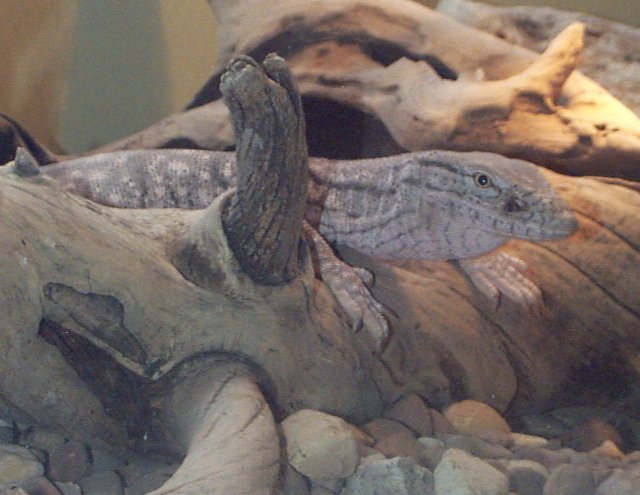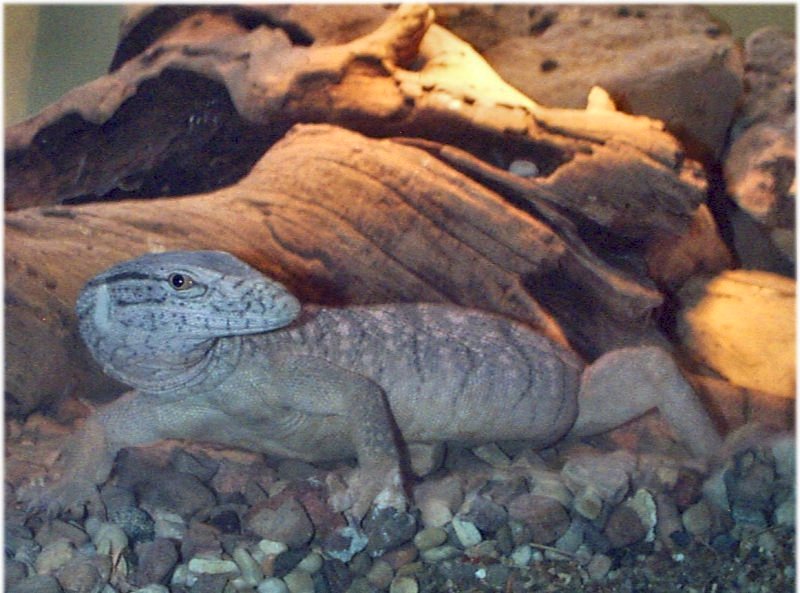 .
.
Physical Description:
These lizards are brownish-yellow with crossbands on the body and tail. The number of crossbands depends on subspecies, but ranges from 3-8 on the body and 8-28 on the tail.
There are three subspecies of the Varanus griseus: caspius (Caspian desert monitor), griseus (western desert monitor, and koniecznyi (Thar desert monitor). The Caspian monitor is the largest (up to 140 cm and 2.8 kg) and the Thar monitor the smallest (up to about 80 cm and 180 grams). The tail is longer than the body. Males are larger than females.
Their nostrils are nearer to the eye rather than to the tip of the snout.
Special Adaptations:
These are burrowing lizards and the position of the nostrils helps to keep dirt out. Salt glands help to minimize water loss. They can run up to 20 mph for short periods of time.
Reports that this lizard is actually venomous (as opposed to having the bacteria-laden mouth of many monitors) have been unsubstantiated.
Social Organization and Behavior::
These lizards are solitary or organized into loose communities composed of overlapping ranges. They maintain large home ranges and may forage up to 2 km from their home burrows. Males hold larger territories than females. Males change home ranges annually, but females may keep to the same range for several years.
For several months between November and March, desert monitors hibernate in their burrows. During the hot part of the year, desert monitors retreat to their burrows during the midpart of the day.
Reproductive Behavior:
Mating and egglaying occur in the late spring and summer and hatchlings
emerge from burrows the following spring. Incubation period for the
eggs is 8-12 weeks, depending on temperature. Tsellarius and Tsellarius
have reported extended periods of premating "escorting," but
this activity may represent a prolonged unsuccessful courtship of females
by males.
Page Author:
Tyler Mabry saisa03@aol.com

Sources and Links:
Harry Foundalis. The Desert Monitor
http://www.cogsci.indiana.edu/farg/harry/bio/zoo/griseus.htm
M. R. Tayab. Desert Monitor Lizard:
http://www.qp.com.qa/raslaffan/rlc.nsf/85797bc91b29
bb56432569c1003d7dad/
1ac69d5669b50f3343256aa7001ac105/
$FILE/Protection%20of%20Desert%20Monitor%20Lizard.pdf
Gray Monitor: Sedgewick County Zoo.
http://www.scz.org/animals/m/gmonitor.html
David Bennett. Little Book of Monitor Lizards.
http://mampam.50megs.com/monitors/griseus.html
Russian Journal of Herpetology:
http://www.folium.ru/en/journals/rjh/contents/1996/1996-02.htm
Adel Ibrahim. Activity area, movement patterns, and habitat use of the desert monitor, Varanus griseus, in the Zaranik Protected Area, North Sinai, Egypt. http://www.wits.ac.za/haa/Ibrahim%2051(1)%2035-45.pdf
